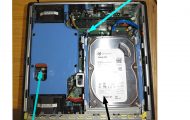Articles
Motorola unveils Project Ara, customizable smartphone effort | CNET
Motorola’s ‘Project Ara’ modular smartphone setup switches out hardware like apps | Engadget
Project Ara: Motorola Wants to Make Your Smartphone Modular | Mashable
My Comments
The IBM PC of 1981 had not just become the standard for a business-class desktop computer as far as software was concerned but epitonised the concept of a highly-modular hardware design. This was highly evident in the way the computer’s system unit was designed where there were user-upgradeable parts, a concept that was so heavily underscored with the PC/AT “second-generation” design.
Here these computers had a continuous update and upgrade lifecycle where one could install faster microprocessors, highly-capable graphics cards, hard disks of increasing capacity, increased RAM, newer secondary-storage media like backup tapes, 3.5” disks and CD-ROMs along with various communications devices like modems and network cards. This capability evolved with the ATX form factor along with newer smaller form-factors such as microITX.
In my experience with desktop computers since the early 1990s, I kept “dragging through”components from a previous chassis to a newer chassis to keep them useful and valid while being able to, in some cases, junk dud components like power supplies with nearly-worn-out fans and replace them myself. This has allowed me to maintain a longer service life for my desktop computing experience.and achieve this goal with minimal expense.
Similarly, I have seen most offices equipped with computers that have the “right mix” of software and hardware but where most of the componentry is affordable and the only expensive aspects of the system are components that suit a particular job. For that matter, this modularity opened up the business desktop-computing boom in the late 1980s.
Now Google’s Motorola smartphone arm is bringing this concept to the smartphone in the form of “click-together” components that snap on to a “skeleton” which is similar to a PC’s motherboard. Google wanted to achieve a platform for the hardware like what Android has done for the software. The goal with the Ara platform would be to have user-replaceable processors, displays, keyboards and the like that also allow these phones to work to newer technologies or work to specific needs.
For example, a higher-capacity flash storage could be planted in these phones or a Bluetooth module compliant to the latest Bluetooth specification could come in to play here. Similarly, the cracked screen could be easily replaced with something newer and brighter or an extra switch array could come in to place for one-touch access to functions. A newer sensor could come in to place to allow the phone to measure newer quantities as a dual-band 802.11ac Wi-Fi radio links the phone to the networks.
Of course this will lead to the longer service life for these phones as people “spin them out” further to their ever-changing needs and as technology marches onwards.


